fall inside a hole
 |
Bandai Mini Mini Rail
First written October 2024Expanded January, April, June-July 2025
Bandai produced and sold the Mini Mini Rail (ミニミニレール) series of train toys in Japan from 1974 until around 1982. The range features fairly small trains about the same size as N scale trains and aimed to be a more toylike alternative to N scale, which was more expensive and primarily imported into Japan in the 1970s until ranges and makers like Tomix and Gakken began to expand Japanese N scale production and the Japanese N scale market, leading to the N scale boom and the surviving prevalence of N scale in Japan. Bandai had released a similar series of battery powered cars as the Mini Mini Car series the year before - the small size of these cars relative to traditional diecast cars which are often referred to as "mini cars" (this is where the mi and ca in Tomica come from - Tomy mini car) seems to be where the "Mini Mini" name comes from. Other toys like Tomy's Super Rail also aimed to offer an N scale alternative toy train system, and lived on for longer than Mini Mini Rail, and Bandai released the B Train Shorty series of toy trains even closer in gauge to N scale trains in the 2000s.
An archived version of an old Japanese website that covers many other Mini Mini Rail sets and trains can be found here. Yonezawa also released the small My Rail series around 1975, which had reversing features from its introduction, but it did not last for long... Like most all other Japanese toys dating from 1972 to present day, the ST toy safety mark and number will signify what year the toy passed testing.
Sets
Mini Mini Rail sets ranged from basic oval sets up to large branching sets with double track sections and elevation. Early sets were generally smaller with later sets having larger layouts and more track varieties.
Early Mini Mini Rail sets (1974-1975)
When Mini Mini Rail was very first introduced in 1974 it seems there was only a No. 1 set but soon after there were three numbered sizes of sets; the oval No. 1 set, the oval-with-passing-loop No. 2 set, and the larger double oval with turnouts and crossover rail No. 3 set. Each of these sets was sold in D-51, Hikari, and National Railway versions. A No. 2 set with D-51 and two freight cars also appeared in this generation. These early boxes proclaim that they are the smallest in the world that run on batteries.
| Year | Set name | Description | Photo |
|---|---|---|---|
| 1974 | 2271 Mini Mini Rail No. 1 National Set (Hikari, D-51 Locomotive, National Railways) | The earliest Mini Mini Rail set, with a different design of box and cover, an oval set sold with the three initial types of trains | National Railways version can be seen here |
| 1974 | 2272 Mini Mini Rail No. 1 Hikari Set | Oval set with 0 series Shinkansen | |
| 1974 | 2273 Mini Mini Rail No. 1 D-51 Locomotive Set | Oval set with D-51, tender, and passenger car |
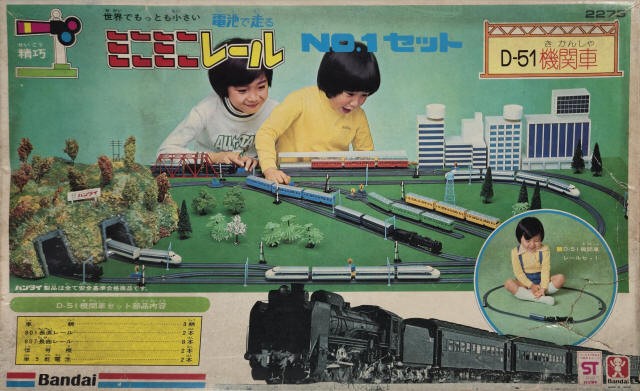 |
| 1974 | 2274 Mini Mini Rail No. 1 National Railways Set | Second No. 1 style set with JNR 103 series in four different colors | |
| 1975 | 2275 Mini Mini Rail No. 2 D-51 Locomotive Freight Car Set | Medium oval with inner loop set with D-51 with freight cars | Can be seen here |
| 1974 | 2276 Mini Mini Rail No. 2 Hikari Set | Earlier oval with passing loop set with Hikari Shinkansen |
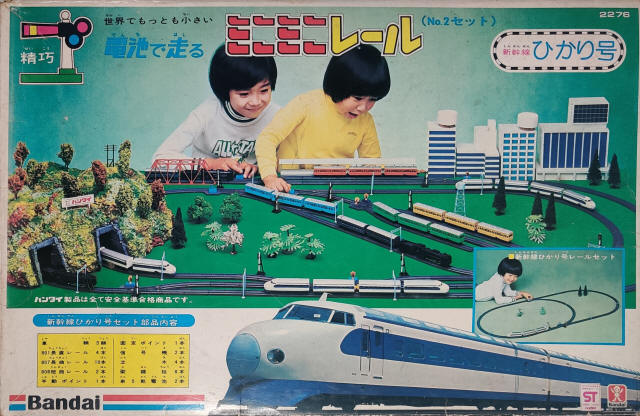 |
| 1974 | 2277 Mini Mini Rail No. 2 D-51 Locomotive Set | Passing loop set with D-51 steam locomotive and passenger car | Can be seen here |
| 1974 | 2278 Mini Mini Rail No. 2 National Railway Set | Medium number 2 set with 103 series commuter train - green, in this case |
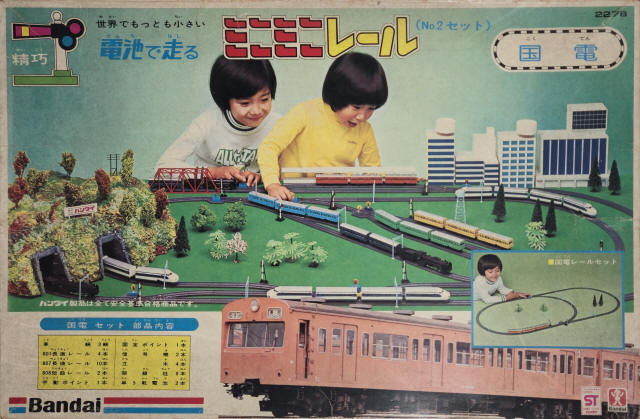 |
| 1974 | 2280 Mini Mini Rail No. 3 Hikari Set | Large set with Hikari | |
| 1974 | 2281 Mini Mini Rail No. 3 D-51 Locomotive Set | Overlapping loop set with D-51 and passenger car | |
| 1974 | Mini Mini Rail No. 3 National Railways Set | Loop and crossing set with National Railways train in one of four colors |
Action Serise Mini Mini Rail sets (1976-1977)
In 1976 most of the Mini Mini Rail range was converted over to use the first version of the reversing chassis that used two N batteries. The original yellow and green boxed sets from 1976 were a No. 1 oval set, a No. 2 oval with siding, a No. 3 oval with reversing loop and siding, and the new No. 4 set with double rail and an elevated section as well, all with reversing and stop rails to show off the train's action features. The early boxes called this the Action Serise (sic).
| Year | Set name | Description | Photo |
|---|---|---|---|
| 1977 | 2288 Action Serise Mini Mini Rail No 2 Limited Express Set | Oval with inner siding set with early Action Series Limited Express |
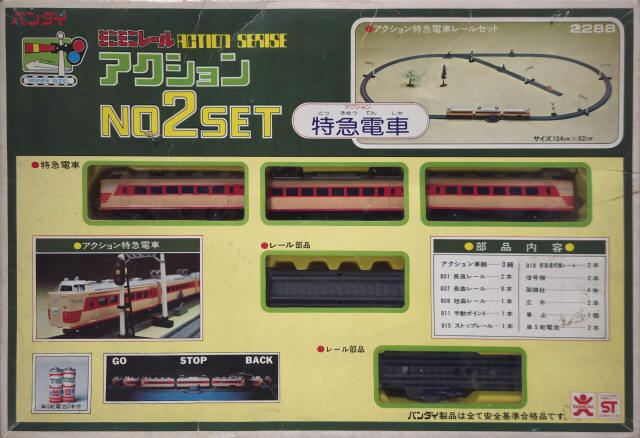 |
| 1976 | 2289 Action Serise Mini Mini Rail No 3 EF65 Electric Locomotive Set | Early Action Series set with EF65-led freight train with a reversing loop and siding |
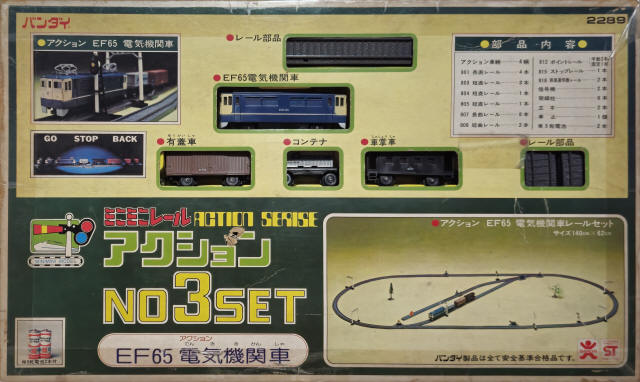 |
| 2291 Action Serise Mini Mini Rail No 2 Hikari Set | Oval with siding set with reversing Hikari | ||
| 2293 Action Serise Mini Mini Rail No 3 Sleeper Express Train Set | Reversing loop oval set with 583 series Sleeper Express train | ||
| 2294 Action Serise Mini Mini Rail No 1 Hikari Set | Basic oval set with Action Series Hikari... but none of the action rails | ||
| Action Serise Mini Mini Rail No 4 Hikari Set | Largest set with double-track section and elevated portion with 0 series Shinkansen |
Action Series Mini Mini Rail sets (~1978-~1981)
The second wave of Action Series sets came with the development of the AA chassis. These sets were larger, with the No. 1 set still being an oval but the No. 2 set incorporating double track curves and three turnouts. The No. 3 sets of the generation featured gimmicks like automatic coupling or more complex accessories. The large No. 4 set also returned.
| Year | Set name | Description | Photo |
|---|---|---|---|
| 16301 Action Series Mini Mini Rail No. 1 Shinkansen Hikari Set | Small Hikari set with stop and reversing rails making up the side of the oval | ||
| 16302 Action Series Mini Mini Rail No. 1 C-62 Steam Locomotive Set | Oval set with new reversing steam locomotive C-62 - because the power car is in the coach | ||
| 16305 Action Series Mini Mini Rail No. 2 Express Train Set | Double track reversing No. 2 set with 485 series train | ||
| 1978 | 16315 Action Series Mini Mini Rail No. 3 EF71 Electric Locomotive Horn Set | Action Series loop set with siding and whistling railroad crossing |
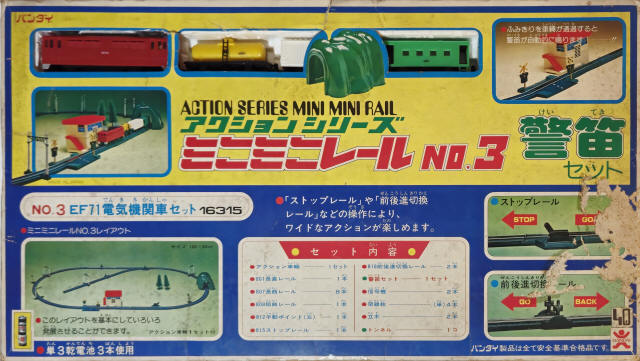 |
| 16316 Action Series Mini Mini Rail No. 3 Automatic Coupling Action EF-71 Electric Locomotive Set | The only coupling gimmick-equipped Mini Mini Rail set, with EF-71, freight train, and double track crossover loop with switches | ||
| 16318 Action Series Mini Mini Rail No. 4 Hikari Shinkansen 3D Set | Largest set layout with elevated section and reversing Hikari | ||
| 1978 | 16321 Action Series Mini Mini Rail No. 2 Blue Train Set | Action Series number two set with reversing loop, double rail section, and Blue Train sleeper express |
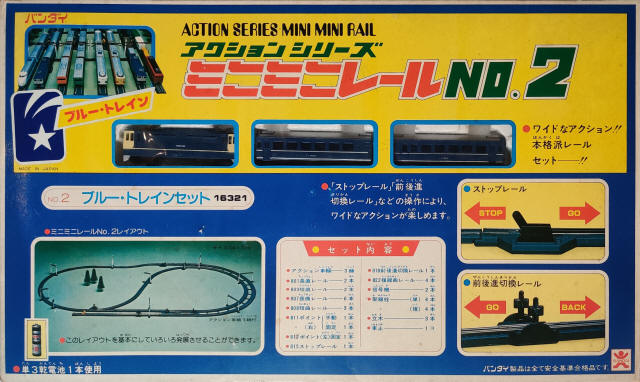 |
| 16322 Action Series Mini Mini Rail No. 2 DD51 Diesel Locomotive Set | Less common No. 2 set with DD-51 diesel and container cars | ||
| ~1981 | 16324 Action Series Mini Mini Rail No. 2 Tohoku Joetsu Shinkansen Set | No. 2 set with new 200 series Shinkansen |
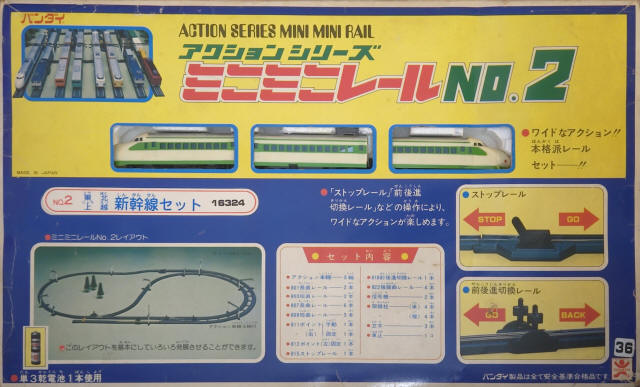 |
Later Action Series sets (~1981-~1985)
In the early 1980s the boxes were redesigned again to have a green background with a large promotional layout shown on the front. Sets began to included papercraft buildings. The numbers were dropped from these releases but followed a similar format. The last sets from right before the range was discontinued had large illustrations of the trains included on the front.
| Year | Set name | Description | Photo |
|---|---|---|---|
| 16330 Action Series Mini Mini Rail Basic Tohoku Joetsu Shinkansen Set | No. 1-style oval set with reversing rail and 200 series Shinkansen in illustrated "train" box | Can be seen here | |
| 16331 Mini Mini Rail Action Series Shinkansen Hikari Set | Green box No. 1 set equivalent with reversing Hikari and papercraft shed | ||
| Action Series Mini Mini Rail Blue Train Set | Double track loop set with siding and EF-65 hauled Blue Train from the "green box" era | ||
| 1981 | 16333 Action Series Mini Mini Rail Tohoku Joetsu Shinkansen Set | Papercraft-era No. 2-style set with 200 series Shinkansen |
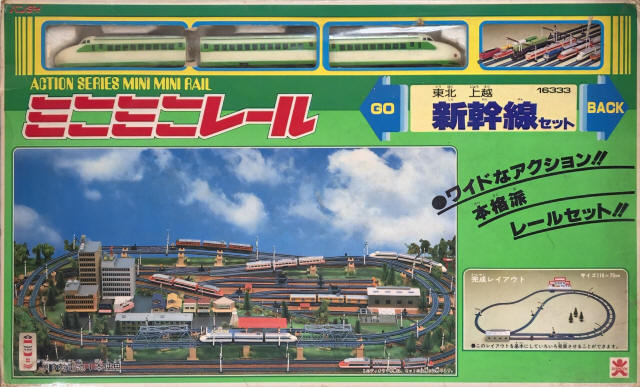 |
| 16334 Action Series Mini Mini Rail TGV French Express Set | No. 2-style set with TGV train in an illustration style box | ||
| 16346 Action Series Mini Mini Rail L Limited Express Set | "Train" style box 485 series set with the largest No. 4 style layout |
Trains
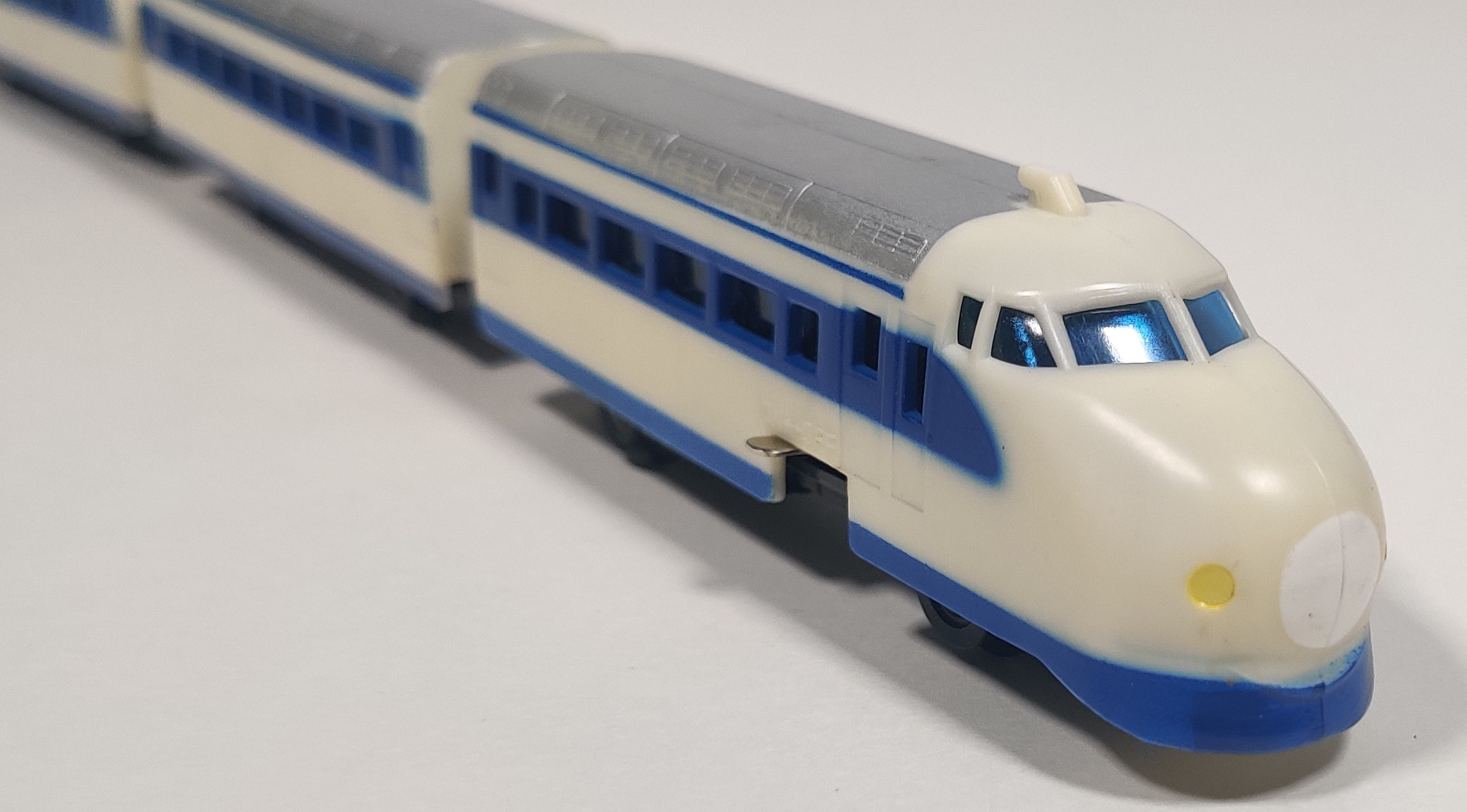

Mini Mini Rail trains are typically three-car sets, with the motor and batteries located either in the locomotive or the intermediate car of the train. The earlier trains are forwards-only, with the later trains having a reversing mechanism.

Trains were sold in sets and individually early on in boxes and later in carded blister packs as three-piece trains. Early Action Series train came on green cards which were followed by orange cards. At the end of its life, private railway and other trains were released on blue cards. The later Action Series did see the introduction of new trains like the 200 series Shinkansen, private railway trains like the old-paint-color Skyliner, and even foreign trains like the TGV.
Early Mini Mini Rail trains (1974-1975)
The original 1975 range consisted of three trains released in individual cardboard boxes as well as the three numbered 1, 2, and 3 sets of the era, with the EF-65 tooling introduced towards the end of this era. These trains all use the original forward-only chassis.
| Year | Name | Description | Photo |
|---|---|---|---|
| 1974 | Hikari Shinkansen | Original forward-only 0 series Shinkansen |
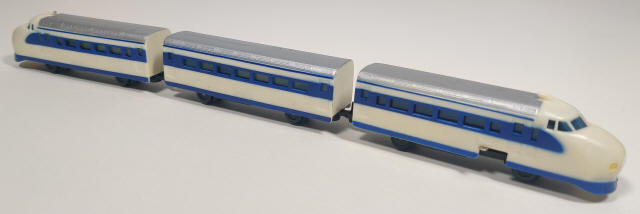 |
| 1974 | D-51 Steam Locomotive | D-51 steam locomotive sold individually and in sets with a passenger car |
 |
| 1974 | National Railways Train | JNR 103 series commuter train in four colors |
 |
| By August 1975 | D-51 Locomotive Freight Train | D-51 steam locomotive with tanker and log wagon |
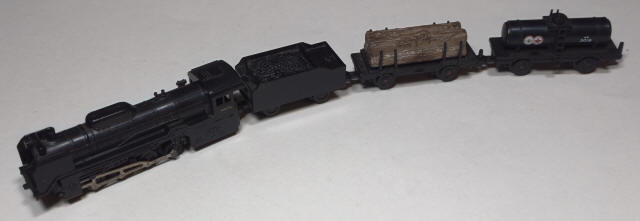 |
| By August 1975 | EF-65 Freight Train | The last new tooling from the original unidirectional series, an EF-65 locomotive and freight cars sold in an individual box |
 |
| By August 1975 | EF-65 Passenger Train | EF-65 with 10 series passenger cars |
Early Action Series trains (1976-1977)
In 1976 almost all of the existing range was first reversing Action Series chassis was based on the original with the new reversing switch sticking out towards the front of the left side of the train or carriage like the power switch of the original trains. The original series, sold as the "Action Serise" (sic), appeared in sets as well as green-card-back blisters. Later, the early two-N battery chassis trains were sold on orange cards. The old non-Action-Series D-51 trains were still sold into this earlier era before the C-62 was developed.
| Year | Name | Description | Photo |
|---|---|---|---|
| 1976 | Hikari Shinkansen | Original Action Series Hikari with reversing chassis in the front car | |
| 1976 | National Railways Train | Four original JNR 103 series colors plus a new plated version | |
| 1976 | EF-65 Freight Train | Reversing EF-65 locomotive with freight train |
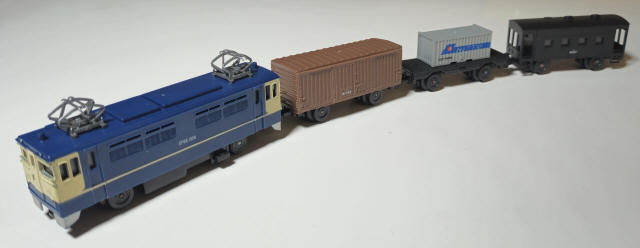 |
| 1976 | EF-65 Passenger Train | Action Series EF-65 with two 10 series coaches | |
| 1976 | EF-71 Freight Train | Red EF-71 with freight train | |
| 1976 | EF-71 Passenger Train | EF-71 with two 10 series coaches | |
| 1976 | 485 Series Express Train | 485 series Express Train, sold in both intermediate and front car power versions |
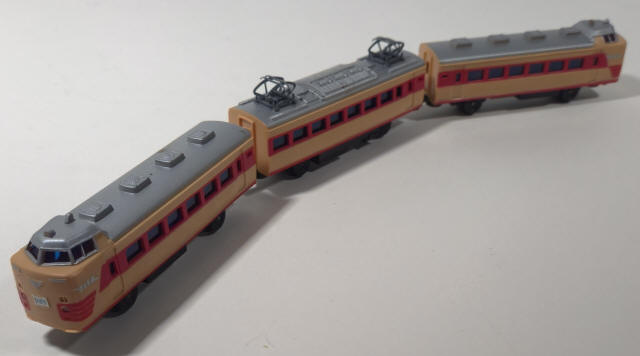 |
| 1976 | 583 Series Sleeper Express Train | Reversing sleeper express train |
 |
Action Series trains (1978-1982)
A new AA-powered reversing chassis was developed for the later and longer-running Action Series run, with most trains again being updated slightly to use the new chassis. Externally, these trains can be differentiated from their earlier counterparts by the reversing lever now being more centered on the side of the chassis and the power switch now being towards the front wheels instead of rear.
| Year | Name | Description | Photo |
|---|---|---|---|
| 1978 | Hikari Shinkansen | Later Action Series Hikari with powered intermediate car | |
| 1978 | Blue Train | EF-65 with two 24-series Blue Train sleeper cars |
 |
| 1978 | EF-71 Freight Train | Red EF-71 with freight train |
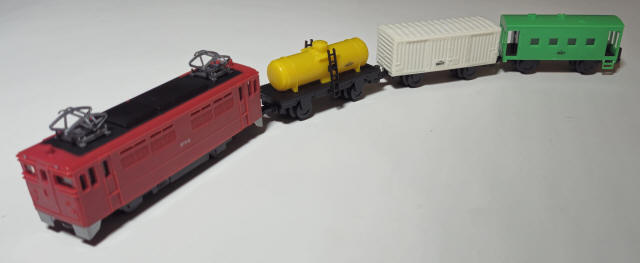 |
| 1978 | 485 Series Express Train | 485 series Express Train with new chassis | |
| 1978 | 583 Series Sleeper Express Train | AA-powered sleeper express train | |
| 1978 | C-62 Steam Locomotive | C-62 2 Tsubame steam locomotive with tender and powered coach |
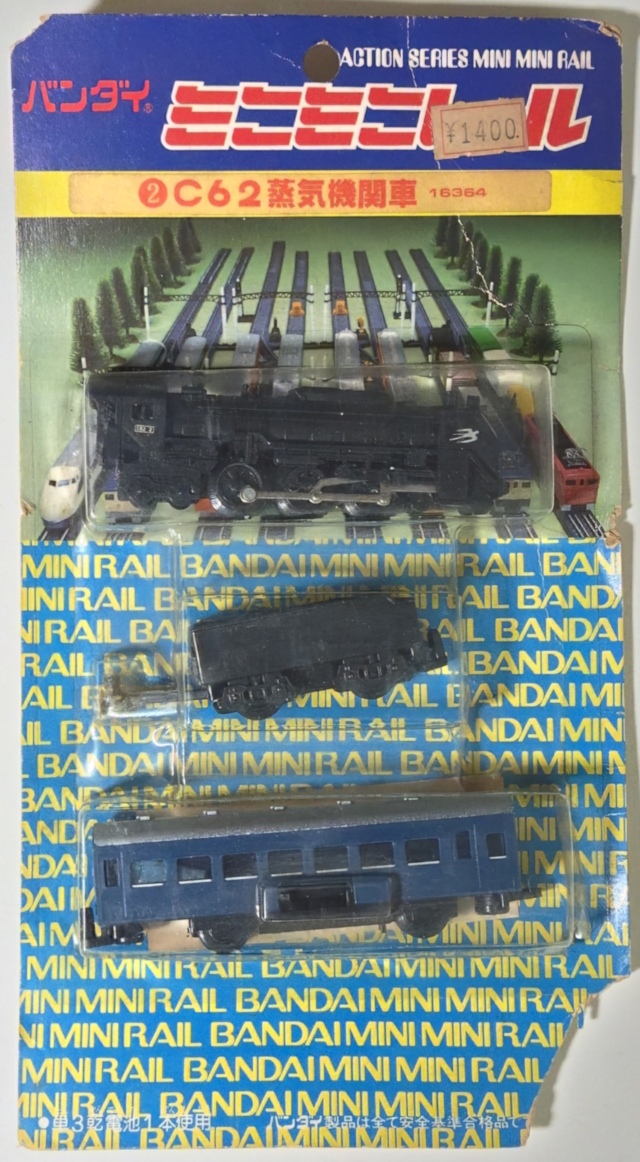 |
| 1981 | Tohoku Joetsu Shinkansen | 200 series Shinkansen |
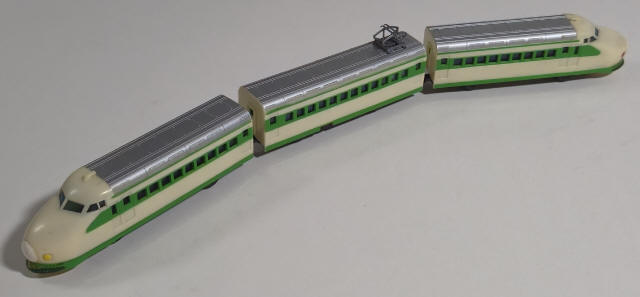 |
Rail
For a relatively niche small plastic train system, Bandai released a fairly wide variety of rails for the system, in particular many lengths of straight rails of different proportions of one another, allowing for many rail variations to work together. The original rail used into the early Action Series was all grey, changing to blue with grey-painted rails in the later Action Series period.
| Year | Name | Description | Photo |
|---|---|---|---|
| 1974 | 801 Long Straight Rail | ~217mm long "standard" straight rail in grey |
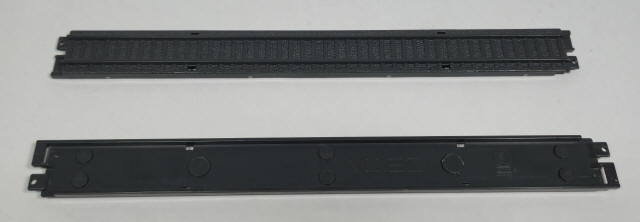 |
| 1974 | 802 Short Straight Rail | The shortest straight produced, about 20mm long | |
| 1974 | 803 Short Straight Rail | Grey 154mm straight rail |
 |
| 1974 | 804 Short Straight Rail | 135mm straight rail |
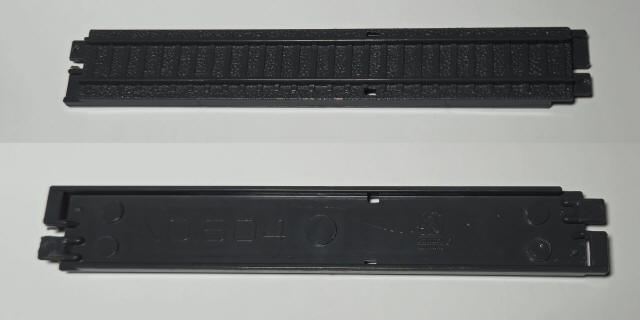 |
| 1974 | 805 Short Straight Rail | "Half" straight rail measuring ~108mm |
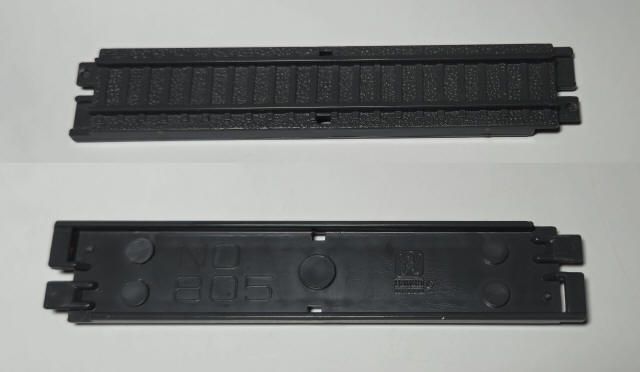 |
| 1974 | 806 Short Straight Rail | ~54mm long straight rail, one quarter the length of an 801 | |
| 1974 | 807 Long Curved Rail | Standard 280mm radius 45 degree curve rails, sold in a pack of four |
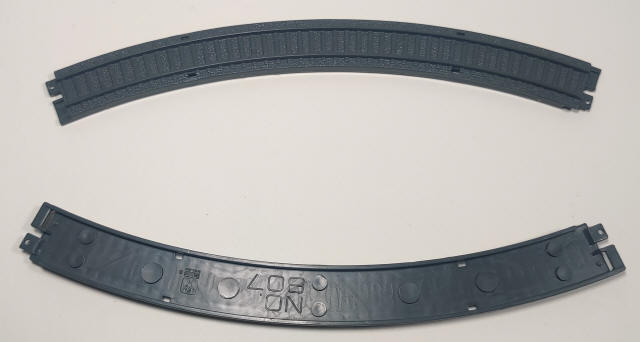 |
| 1974 | 808 Short Curved Rail | Standard radius curve but half the length of the 807, 16 to a circle |
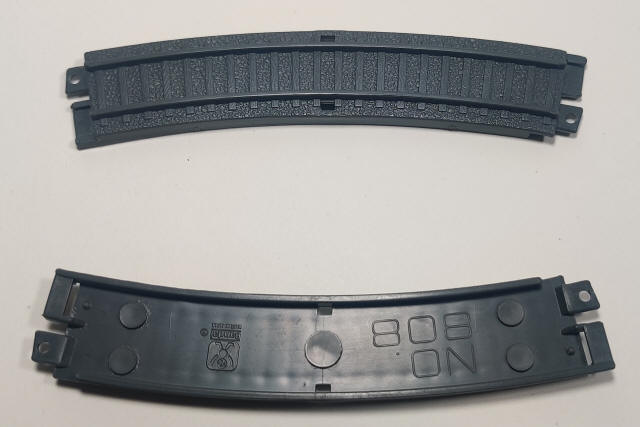 |
| 1974 | 809 Short Straight Rail | "One fifth" straight rail measuring ~43mm | |
| 1974 | 810 Short Straight Rail | ~36mm straight rail, 1/6th of a standard straight | |
| 1974 | 811 Points (Right) | Manual or automatic right hand point rail |
 |
| 1974 | 812 Points (Left) | Left hand point produced in both manual and automatic straight-thru versions |
 |
| 1976 | 815 Stop Rail | Stop rail for the new Action Series trains |
 |
| 1974 | 816 Cross Rail | Angled crossover section |
 |
| 1976 | 818 Forward/Reverse Switch Rail | Reversing Action Series rail in grey |
 |
| 1976 | 819 Slope Rail | Two-part sloping bridge rail with supports, sold in pairs |
 |
| 1975 | 822 Double Curved Rail | Grey double track curves, with a ~323mm outer radius track outside a "regular" curve |
 |
| ~1978 | 801 Long Straight Rail | ~217mm long "standard" straight rail in blue |
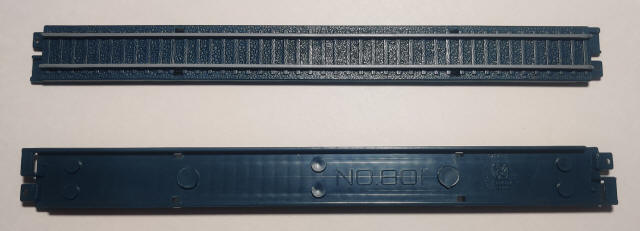 |
| ~1978 | 803 Short Straight Rail | Blue and grey 154mm straight rail |
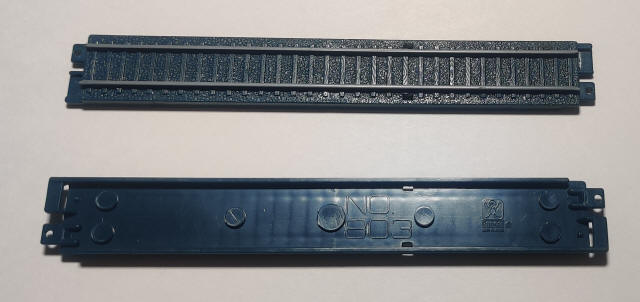 |
| ~1978 | 804 Short Straight Rail | 135mm straight rail |
 |
| ~1978 | 805 Short Straight Rail | "Half" straight rail measuring ~108mm | |
| ~1978 | 807 Long Curved Rail | Standard 280mm radius 45 degree curve rails, sold in a pack of four |
 |
| ~1978 | 808 Short Curved Rail | Blue half curve rail |
 |
| ~1978 | 811 Points (Right) | Manual or automatic right hand point rail |
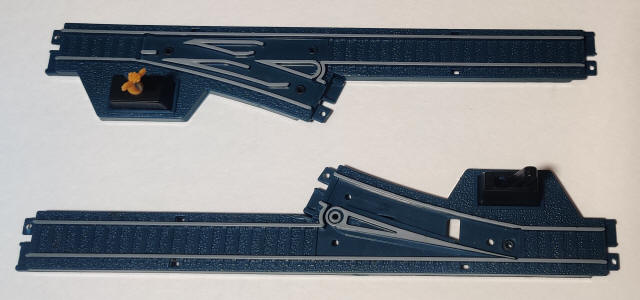 |
| ~1978 | 812 Points (Left) | Left hand point produced in both manual and automatic straight-thru versions |
 |
| ~1978 | 815 Stop Rail | Stop rail for the new Action Series trains |
 |
| ~1978 | 816 Cross Rail | Blue angled crossover rail | |
| ~1978 | 818 Forward/Reverse Switch Rail | Reversing Action Series rail in blue |
 |
| ~1978 | 819 Slope Rail | Blue sloping rails with support girders | |
| ~1978 | 822 Double Curved Rail | Grey double track curves, with a ~323mm outer radius track outside a "regular" curve |
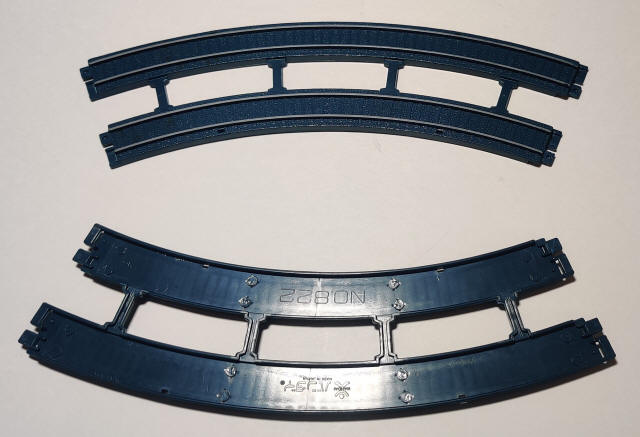 |
| ~1981 | 827 Small Curved Rail | New smaller radius curve introduced later on |
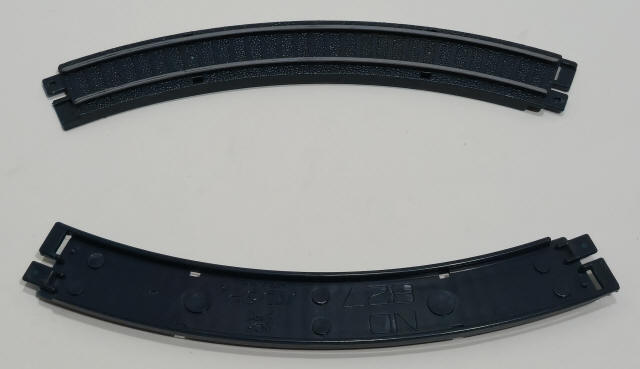 |
Accessories
In addition to signals, wire catenary, and trees included in sets, Bandai produced individual release stations, tunnels, bridges, and other accessories.
| Year | Name | Description | Photo |
|---|---|---|---|
| 1974 | 851 Tunnel | Curved tunnel with flocked top |
 |
| 1974 | 852 Iron Bridge | Reconfigurable single or double track iron bridge |
 |
| 1976 | 875 Bridge Girder | Set of six girders to hold up elevated rail |
 |
| 1978 | Horn Railroad Crossing | Railway crossing with train-activated acoustic whistle "horn" |
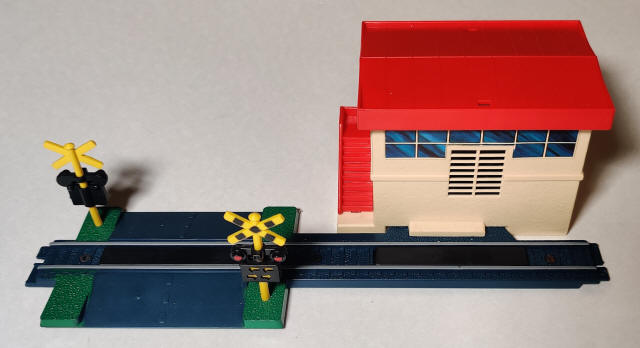 |
Catalogues
The original Mini Mini Rail catalogue was a light blue with the landscaped layout shown on most of the early period's boxes, with two green covered catalogues accompanying the early Action Series in 1976 and 1977. After that, other blue "Mini Mini Rail for You" catalogues were printed in the later Action Series era, but I do not currently have a clear timeline for them
| Year | Name | Description | Photo |
|---|---|---|---|
| 1974 | Bandai Mini Mini Rail Catalog | 1974 Mini Mini Rail catalogue with the earlier unidirectional range |
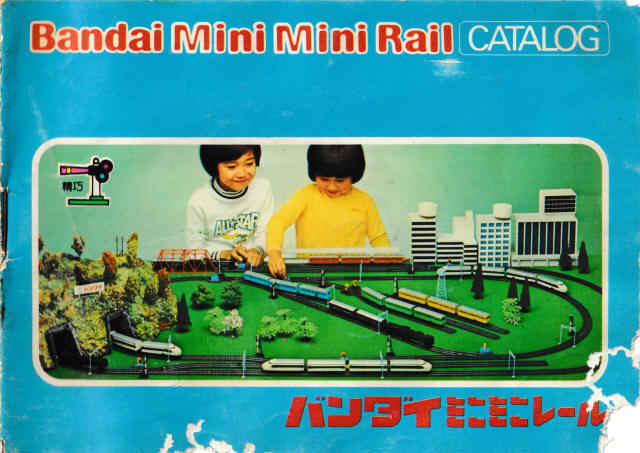 |
| 1976 | Mini Mini Rail For You | 1976 Mini Mini Rail catalogue with early Action Series |
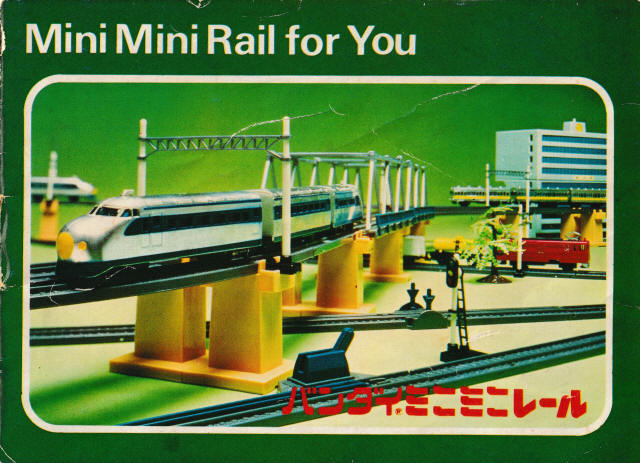 |